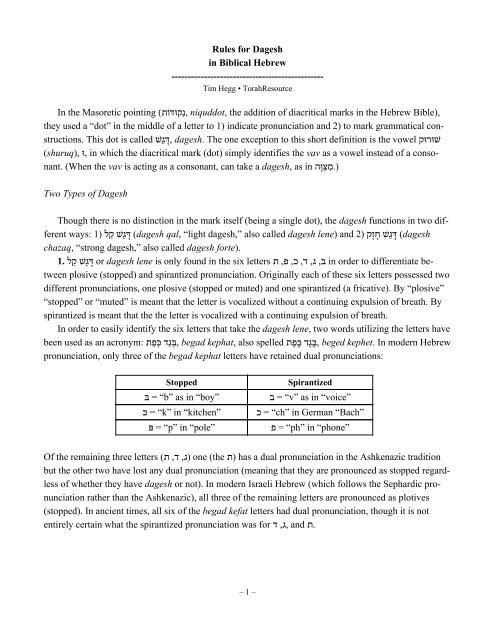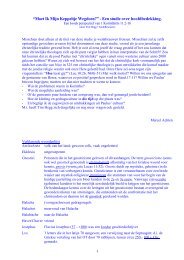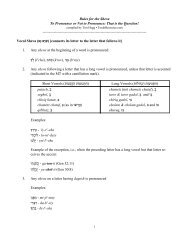Rules for Dagesh in Biblical Hebrew ... - TorahResource
Rules for Dagesh in Biblical Hebrew ... - TorahResource
Rules for Dagesh in Biblical Hebrew ... - TorahResource
Create successful ePaper yourself
Turn your PDF publications into a flip-book with our unique Google optimized e-Paper software.
<strong>Rules</strong> <strong>for</strong> <strong>Dagesh</strong><br />
<strong>in</strong> <strong>Biblical</strong> <strong>Hebrew</strong><br />
-----------------------------------------------<br />
Tim Hegg • <strong>TorahResource</strong><br />
In the Masoretic po<strong>in</strong>t<strong>in</strong>g (תוֹדּוּקִנ, niquddot, the addition of diacritical marks <strong>in</strong> the <strong>Hebrew</strong> Bible),<br />
they used a “dot” <strong>in</strong> the middle of a letter to 1) <strong>in</strong>dicate pronunciation and 2) to mark grammatical constructions.<br />
This dot is called שֵׁגדּ, ָ dagesh. The one exception to this short def<strong>in</strong>ition is the vowel קוּרוּשׁ<br />
(shuruq), וּ, <strong>in</strong> which the diacritical mark (dot) simply identifies the vav as a vowel <strong>in</strong>stead of a consonant.<br />
(When the vav is act<strong>in</strong>g as a consonant, can take a dagesh, as <strong>in</strong> הָ וְּצִמ.)<br />
Two Types of <strong>Dagesh</strong><br />
Though there is no dist<strong>in</strong>ction <strong>in</strong> the mark itself (be<strong>in</strong>g a s<strong>in</strong>gle dot), the dagesh functions <strong>in</strong> two different<br />
ways: 1) לַ ק שֵׁגדָּ (dagesh qal, “light dagesh,” also called dagesh lene) and 2) קָ זח ָ שֵׁגדָּ (dagesh<br />
chazaq, “strong dagesh,” also called dagesh <strong>for</strong>te).<br />
1. לַ ק שֵׁגדָּ or dagesh lene is only found <strong>in</strong> the six letters ת , פ , כ , ד , ג , ב <strong>in</strong> order to differentiate between<br />
plosive (stopped) and spirantized pronunciation. Orig<strong>in</strong>ally each of these six letters possessed two<br />
different pronunciations, one plosive (stopped or muted) and one spirantized (a fricative). By “plosive”<br />
“stopped” or “muted” is meant that the letter is vocalized without a cont<strong>in</strong>u<strong>in</strong>g expulsion of breath. By<br />
spirantized is meant that the the letter is vocalized with a cont<strong>in</strong>u<strong>in</strong>g expulsion of breath.<br />
In order to easily identify the six letters that take the dagesh lene, two words utiliz<strong>in</strong>g the letters have<br />
been used as an acronym: תַפְכּ דַגְבּ,<br />
begad kephat, also spelled תֶפֶכּ דֶגֶבּ,<br />
beged kephet. In modern <strong>Hebrew</strong><br />
pronunciation, only three of the begad kephat letters have reta<strong>in</strong>ed dual pronunciations:<br />
Stopped Spirantized<br />
בּ = “b” as <strong>in</strong> “boy” ב = “v” as <strong>in</strong> “voice”<br />
כּ = “k” <strong>in</strong> “kitchen” כ = “ch” <strong>in</strong> German “Bach”<br />
פּ = “p” <strong>in</strong> “pole” פ = “ph” <strong>in</strong> “phone”<br />
Of the rema<strong>in</strong><strong>in</strong>g three letters ( ת , ד , ג)<br />
one (the ת) has a dual pronunciation <strong>in</strong> the Ashkenazic tradition<br />
but the other two have lost any dual pronunciation (mean<strong>in</strong>g that they are pronounced as stopped regardless<br />
of whether they have dagesh or not). In modern Israeli <strong>Hebrew</strong> (which follows the Sephardic pronunciation<br />
rather than the Ashkenazic), all three of the rema<strong>in</strong><strong>in</strong>g letters are pronounced as plotives<br />
(stopped). In ancient times, all six of the begad kefat letters had dual pronunciation, though it is not<br />
entirely certa<strong>in</strong> what the spirantized pronunciation was <strong>for</strong> ד , ג,<br />
and ת.<br />
– 1 –
Ashkenazi Sephardic Ancient (?)<br />
גּ = “g” / ג = “g” גּ = “g” / ג = “g” גּ = “g” / ג = “g” as <strong>in</strong> “genre”<br />
דּ = “d” / ד = “d” דּ = “d” / ד = “d” דּ = “d” / ד = “th” as <strong>in</strong> “this”<br />
תּ = “t” / ת = “s” תּ = “t” / ת = “t” תּ = “t” / ת = “th” as <strong>in</strong> “th<strong>in</strong>k”<br />
2. קָ זח ָ שֶׁגדָּ or dagesh <strong>for</strong>te <strong>in</strong>dicates the doubl<strong>in</strong>g of the letter <strong>in</strong> which it is found. This would occur<br />
<strong>in</strong> <strong>for</strong>ms where the same letter was written twice consecutively, and scribes used a “short cut” <strong>in</strong> order to<br />
write it only once. For <strong>in</strong>stance, <strong>in</strong> a word such as לטְ ֵטִק*<br />
1 , <strong>in</strong>stead of writ<strong>in</strong>g the ט twice, the first ט with<br />
silent sheva would be represented by a dagesh <strong>for</strong>te <strong>in</strong> the second ט, yield<strong>in</strong>g לטִּק. ֵ Thus, , לֵ טְ טִק*<br />
= לֵ טִּק<br />
חַלְלִשׁ * = חַלִּשׁ,<br />
and דֵלְלַי * = דֵלַּי.<br />
<strong>Rules</strong> <strong>for</strong> <strong>Dagesh</strong> Lene and <strong>Dagesh</strong> Forte ( לַ ק שֶׁגדָּ and קָ זח ָ שֶׁגדָּ) 1<br />
<strong>Dagesh</strong> Lene ( לַ ק שֶׁגדָּ) a. <strong>Dagesh</strong> lene is <strong>in</strong>serted <strong>in</strong> a begat kefat letter <strong>in</strong> most <strong>in</strong>stances when it is the first letter <strong>in</strong> a word<br />
or when it beg<strong>in</strong>s a syllable. (If the begat kefat letter beg<strong>in</strong>s a syllable, it will most times follow a<br />
silent sheva.)<br />
1. At the beg<strong>in</strong>n<strong>in</strong>g of a word: ןֵבּ,<br />
הֶפּ<br />
2. At the beg<strong>in</strong>n<strong>in</strong>g of a syllable: ָתּ ְר , ַמ רֹבָּשׁ ְקִי , רָבְּ דִמ<br />
b. At the end of a word (not the beg<strong>in</strong>n<strong>in</strong>g of a syllable), if a begat kefat letter follows a silent sheva,<br />
it can take the dagesh lene with a silent sheva: ְתּ ְר (sha-mar-t) ַמ ָשׁ<br />
c. Begat Kefat letters usually lose their dagesh lene when the vowel immediately preced<strong>in</strong>g is a full<br />
vowel or a vocal sheva: תִי ַב ְבּ , יִנֹדאֲ , רַ חְבִי,<br />
דֶבֶע<br />
1. This rule applies as well when a begat kefat letter beg<strong>in</strong>s a word when that word is preceded<br />
by a word which ends <strong>in</strong> a vocalized vowel: 2 וֹב־וּר ְבּ ְשׁ ת ִ אֹ לםֶצֶעְ<br />
ו,<br />
“and not a bone shall be broken<br />
of it,” where the f<strong>in</strong>al וֹב is jo<strong>in</strong>ed by maqqef (a raised dash) to וּר ְבּ ְשׁ ת. ִ S<strong>in</strong>ce וּר ְבּ ְשׁ ת ִ ends<br />
<strong>in</strong> a vocalized vowel (shuruq), the follow<strong>in</strong>g ב will not admit a dagesh lene. Likewise, the ת<br />
<strong>in</strong> וּר ְבּ ְשׁ ת ְ loses its dagesh lene because it follows the vocalized cholem <strong>in</strong> אֹ ל. One should remember<br />
that the א of אֹ ל is a mater (plural: matris lectionis), function<strong>in</strong>g as a “vowel marker”<br />
and thus not hav<strong>in</strong>g the l<strong>in</strong>guistic value of a consonant. The same, there<strong>for</strong>e, will occur when<br />
a begat kefat letter is immediately preceded by a word end<strong>in</strong>g <strong>in</strong> any of the matris lectionis,<br />
namely, י , ו , ה , א and is jo<strong>in</strong>ed by a conjunctive accent:<br />
2. An exception to rule #1 above is <strong>in</strong> some words, when the begat kefat letter is the first letter<br />
In l<strong>in</strong>guistic studies, particularly Semitic l<strong>in</strong>guistics, the presence of an asterisk (*) on a given <strong>for</strong>m <strong>in</strong>dicates<br />
that it is a l<strong>in</strong>guistically proposed <strong>for</strong>m and not a <strong>for</strong>m that actually occurs.<br />
2<br />
In the grammar of the Masoretes, the word beg<strong>in</strong>n<strong>in</strong>g with a begad kefat letter which loses its dagesh lene is jo<strong>in</strong>ed to the<br />
previous word with a conjunctive accent, but sometimes the conjunctive accent is presumed and not actually marked.<br />
– 2 –
of an accented syllable, the begat kefat letter will receive the dagesh lene: םִיתַּ ְשׁ (she-ta-yim),<br />
יֵ תְּשׁ (she-tei).<br />
3. Note: the dagesh that appears <strong>in</strong> letters follow<strong>in</strong>g the def<strong>in</strong>ite article is a dagesh <strong>for</strong>te, not a<br />
dagesh lene. Thus, begat kefat letters which are preceded by the def<strong>in</strong>ite article will have a<br />
dagesh <strong>for</strong>te, and <strong>in</strong> this case, the dagesh <strong>for</strong>te acts <strong>in</strong> the same manner as a dagesh lene to<br />
make the begat kefat letter “stopped” (plosive) rather than spirantized: תִי ַב ְבּ (be-vye-it) vs.<br />
תִי ַבּ ַבּ (ba-bye-it). In the second example, the def<strong>in</strong>ite article is conta<strong>in</strong>ed <strong>in</strong> the preposition, as<br />
noted by the vowel (patach) that rema<strong>in</strong>s from the def<strong>in</strong>ite article.<br />
<strong>Rules</strong> <strong>for</strong> <strong>Dagesh</strong> Forte ( קָ זח ָ שְׁגדָּ) 1. Guttural letters ( ר , ע , ח , ה , א)<br />
cannot accept dagesh <strong>for</strong>te. When l<strong>in</strong>guistically they should receive<br />
dagesh <strong>for</strong>te, the preced<strong>in</strong>g vowel is lengthened. This is called “compensatory lengthen<strong>in</strong>g”<br />
or “compensatory heighten<strong>in</strong>g”: הָשִּׁ אָ ה , רי ִעהָ (where the normal patach of the def<strong>in</strong>ite<br />
article is lengthened to qametz s<strong>in</strong>ce the gutturals [ א , ע]<br />
cannot receive dagesh <strong>for</strong>te.)<br />
2. S<strong>in</strong>ce dagesh <strong>for</strong>te substitutes <strong>for</strong> writ<strong>in</strong>g a consonant twice, a sheva under a letter with<br />
dagesh <strong>for</strong>te is always vocal (s<strong>in</strong>ce the orig<strong>in</strong>al consonants would offer two shevas, the first<br />
silent and the second vocal): וּלטְּ ִק = * וּלטְ טְ ִק (qit-te-lu)<br />
3. Certa<strong>in</strong> letters with vocal sheva may omit the dagesh <strong>for</strong>te. These letters are:<br />
a. the sibilants (“s” type letters): שׂ , שׁ , צ , ס<br />
b. the liquid and nasal letters: ל , מ , נ<br />
c. the letters ק , ו , י<br />
d. These letters are known by the memory word יִ וֵל םֶנקֶסְ (seqenem leivi, where the ס stands<br />
<strong>for</strong> all sibilants).<br />
e. Example: יהְיַ ִ ו (where we would expect יהְיַּ ִ ו)<br />
4. <strong>Dagesh</strong> <strong>for</strong>te must be preceded by a vowel. This is usually a short vowel, but may be a long<br />
vowel <strong>in</strong> an accented syllable: רֵבִּק,<br />
הָמֵּ ה,<br />
הֶלֵּ א<br />
5. <strong>Dagesh</strong> <strong>for</strong>te may not beg<strong>in</strong> a word or end a word: םַע but יִמַּע. In this case, the dagesh <strong>for</strong>te is<br />
said “to hover,” i.e., it is suspended. When someth<strong>in</strong>g is added to the end of the word, the<br />
dagesh <strong>for</strong>te “lands,” i.e., appears.<br />
3. Mappiq (קי ִפּ ַמ)<br />
The 3rd fem<strong>in</strong><strong>in</strong>e s<strong>in</strong>gular possessive suffix ה, if left without a diacritic, could often be confused<br />
with the common mater ה of the 3rd fem<strong>in</strong><strong>in</strong>e s<strong>in</strong>gular noun. In order to make the dist<strong>in</strong>ction, a dot<br />
is added to the 3rd fem<strong>in</strong><strong>in</strong>e s<strong>in</strong>gular possessive suffix to mark its dist<strong>in</strong>ction. This dot, while typographically<br />
the same as a dagesh, is actually a mappiq and is not function<strong>in</strong>g as either a dagesh <strong>for</strong>te<br />
or a dagesh lene. Thus, הרֲ ָעָנ<br />
= “young girl” (3rd fem. sg.) and הּרֲ ָעַנ<br />
= “her young man” (3rd masc.<br />
sg. with 3rd fem. sg. possessive suffix).<br />
– 3 –




